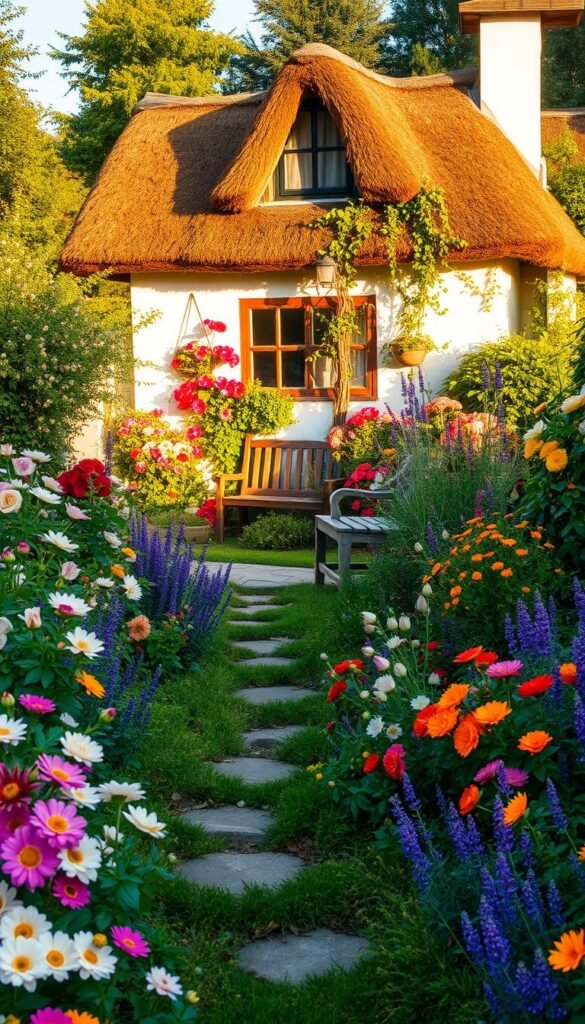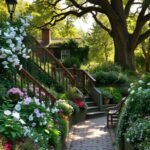Ever feel like your home’s exterior blends into the neighborhood? Traditional landscaping works, but what if you could turn heads with a space that feels alive? Let’s rethink where romantic, free-flowing plantings belong—spoiler alert: your front yard deserves this magic.
Many assume these lush, layered spaces only thrive in backyards. But picture overflowing blooms greeting you daily, softening your home’s edges with color and texture. This approach isn’t just pretty—it’s practical. Front-facing cottage-style designs create instant warmth while boosting curb appeal.
Forget rigid hedges and perfect symmetry. The secret lies in mixing edibles with flowers, letting plants spill onto paths, and embracing a “lived-in” charm. You’ll learn how this philosophy differs from manicured yards, focusing on abundance over order.
Worried about cost or upkeep? These gardens often use drought-tolerant perennials and self-seeding annuals. Start small—even a single flowerbed can transform your entrance. Ready to ditch the ordinary? Let’s explore how to craft a space that whispers “welcome home” with every petal.
Introduction to Cottage Garden Aesthetics
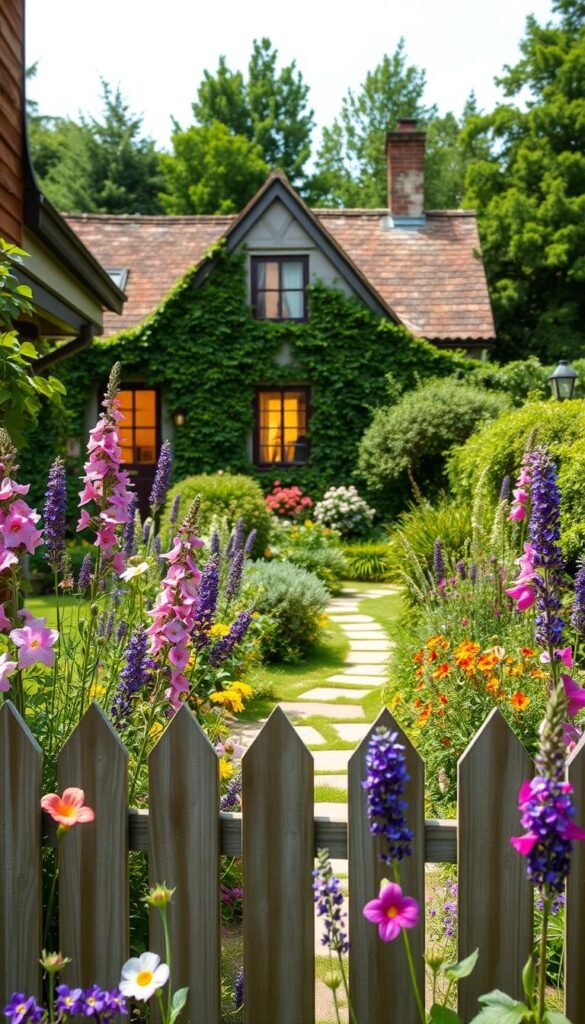
Your home’s entrance sets the tone before guests even knock. Picture lush plantings that sway gently, their colors whispering stories of seasons past and present. This is the heart of cottage garden style—a blend of tradition and modernity that turns ordinary entries into living invitations.
The Allure of a Relaxed, Romantic Style
Imagine pathways framed by lavender and roses, their fragrances mingling like old friends. These spaces thrive on effortless beauty, where foxgloves peek through clusters of herbs and daisies tumble onto walkways. Victorian pioneers like Gertrude Jekyll championed this “controlled chaos,” proving wildness could coexist with intention.
Your front area becomes a sensory experience. Soft grasses brush ankles while climbing clematis frames your door. This approach isn’t messy—it’s artful. Plants layer like watercolors, creating depth that stiff hedges never achieve.
Inspiration from Traditional and Contemporary Designs
Today’s interpretations honor history while solving modern problems. Urban spaces use vertical planters bursting with nasturtiums. Suburban yards mix native perennials with heirloom vegetables. The key? Adaptability.
Designers now prioritize drought-resistant blooms and pollinator-friendly choices. Yet the romantic essence remains: a bench nestled among peonies, stone edges wearing moss like lace. Your space becomes both sanctuary and statement—proof that practicality and poetry can root together.
Understanding the Appeal of Cottage Garden Style
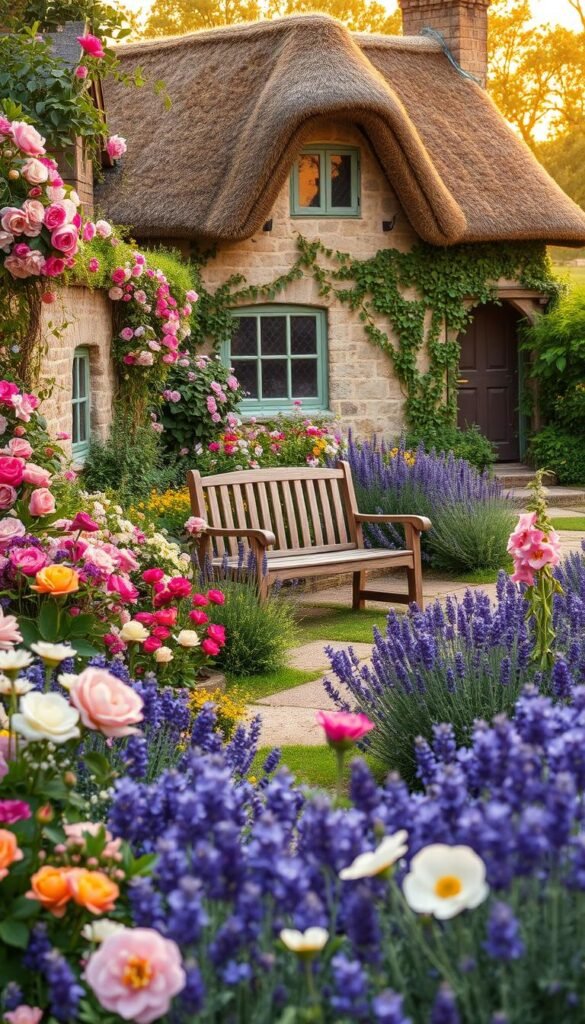
Why do some outdoor spaces feel instantly welcoming? The answer lies in their ability to blend history with modern sensibilities. This approach transforms ordinary plots into living tapestries that engage both eyes and imagination.
Heritage and Modern Adaptations
Originally, these plantings served practical needs. Workers in rural England grew food alongside medicinal herbs, letting beauty emerge naturally. Today’s versions keep that spirit while solving 21st-century challenges.
Urban dwellers now use vertical planters for strawberries and marigolds. Suburban yards mix native perennials with pollinator-friendly blooms. The core principle remains: work with nature, not against it.
Modern updates include drought-resistant varieties and self-seeding annuals. You’re not recreating the past—you’re building a resilient future. As one horticulturist notes, “The best designs honor roots while reaching for new possibilities.”
Creating a Colorful, Inviting Space
Forget rigid layouts. Here, snapdragons cozy up to rosemary bushes, and nasturtiums spill over walkways. This organized wildness creates depth that formal arrangements lack.
Focus on textures and heights. Tall hollyhocks frame shorter calendula, while creeping thyme softens stone edges. Need inspiration? Explore our guide on elevating your space with a gardening.
These spaces do more than look pretty. They reduce stress by connecting you to nature’s rhythms. Your plot becomes a sanctuary where bees buzz and seasons dance—proof that practicality and charm can bloom together.
Cottage Front Garden vs. Front Yard Cottage Garden: Design Differences Explained
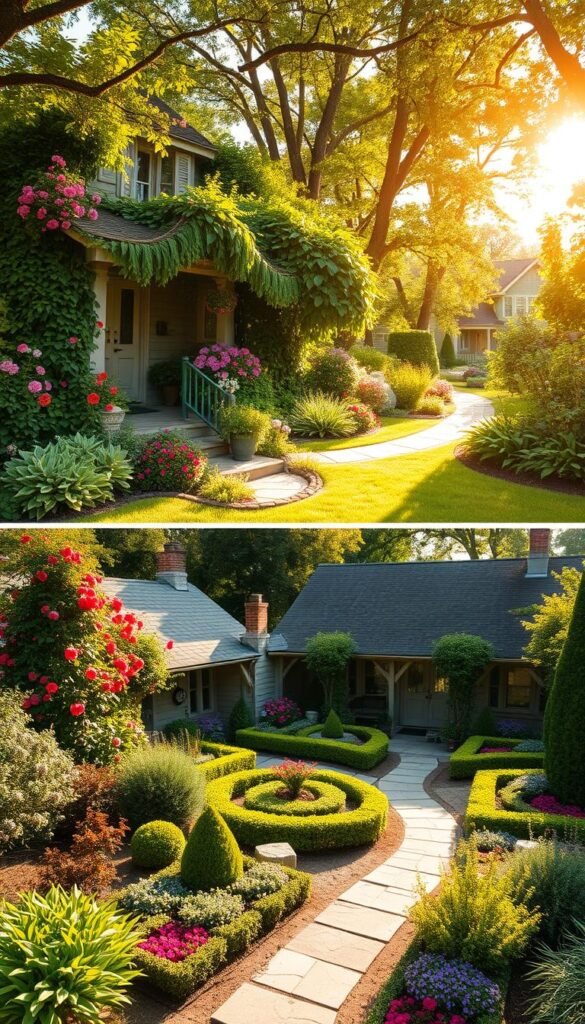
What transforms a simple entryway into a botanical welcome mat? While both approaches celebrate abundant plant life, their execution and scope create distinct experiences. Let’s unpack what makes each option unique.
Key Elements That Set Them Apart
Entry-focused layouts thrive in compact spaces. These designs wrap around doorways, using vertical climbers like roses or clematis to frame entrances. You’ll see window boxes overflowing with herbs and tight clusters of lavender lining walkways. Every plant serves dual purposes—beauty and function.
Full-property installations take a grander approach. Picture winding paths connecting flower beds to seating nooks, with ornamental grasses softening boundaries. These spaces balance structure with spontaneity, using repetition of colors or textures to unify larger areas.
| Feature | Entry-Focused Layout | Full-Property Design |
|---|---|---|
| Space Used | 0-15 ft from entrance | Entire front landscape |
| Key Plants | Climbers, container herbs | Mixed perennials, shrubs |
| Maintenance | Weekly pruning | Zoned care schedule |
| Design Goal | Instant visual impact | Immersive experience |
Maintenance needs vary significantly. Concentrated plantings near doors demand frequent deadheading and watering. Spread-out arrangements let you prioritize areas—maybe keeping roses near paths pristine while allowing distant beds to grow more freely.
Your choice depends on available time and space. Urban dwellers often prefer entry-centric designs for their efficiency. Suburban homeowners might embrace full-yard transformations that become neighborhood landmarks. Both styles prove that romantic charm can flourish anywhere sunlight touches soil.
Planning Your Cottage Garden for Maximum Curb Appeal
Your home’s first impression begins at the curb, where thoughtful planting choices can turn passersby into admirers. Successful cottage garden designs blend ambition with practicality, creating spaces that feel both abundant and intentional. Let’s map out your path to a welcoming entry that makes every arrival memorable.
Assessing Your Space and Existing Features
Begin with a 5×5 foot test plot near your walkway. This manageable start lets you experiment with plant pairings while mastering care routines. Notice how existing trees cast shadows or how rainwater pools near your foundation—these details shape your garden design decisions.
Track sunlight patterns across three days. Morning shade lovers like hostas thrive under eaves, while sun-worshipping coneflowers demand open skies. Sketch these zones to match plants with their ideal conditions.
Sloped areas become opportunities for terraced herbs. Compact spaces? Try vertical planters bursting with trailing nasturtiums. Even poor soil gets a second chance when amended with compost and mulch.
Prioritize year-round interest with these combos:
- Spring: Daffodils + creeping phlox
- Summer: Lavender + black-eyed Susans
- Fall: Ornamental kale + asters
- Winter: Red-twig dogwood + evergreen rosemary
Set a six-month timeline focusing on high-impact areas first. Allocate 60% of your budget to quality soil and perennial plants—they’ll reward you for years. Remember, your front yard transformation unfolds like a favorite story: one captivating chapter at a time.
Crafting Inviting Paths and Sidewalk Borders
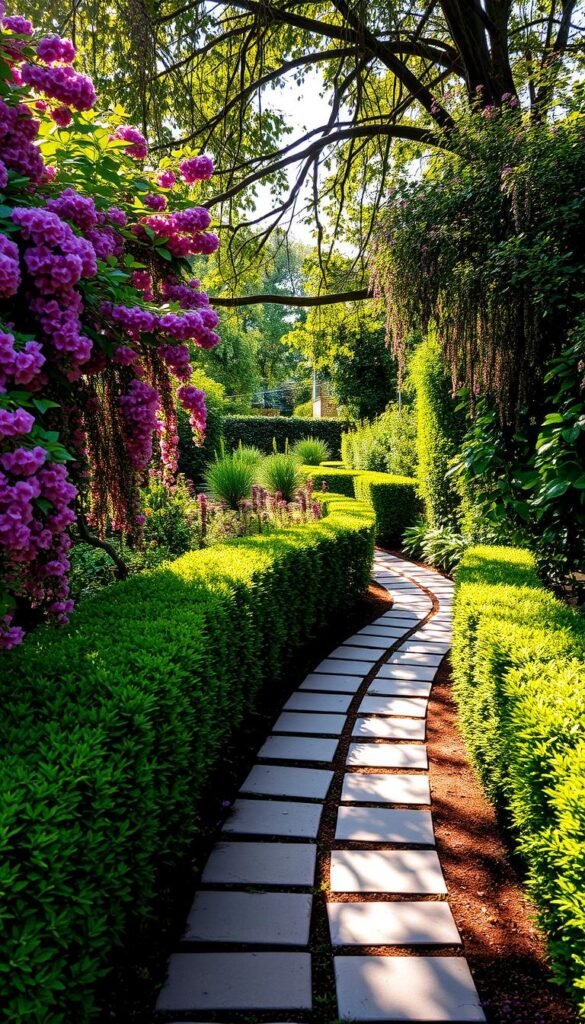
Your pathway isn’t just a route—it’s the first handshake between your home and visitors. Existing walkways become opportunities when treated as living frames for your plantings. Whether you’re working with concrete slabs or uneven pavers, clever landscaping ideas can turn functional paths into storybook trails.
Designing Stepping Stone Pathways
Irregular stone placements create instant whimsy. Space flat rocks 6-8 inches apart, allowing creeping thyme or moss to fill gaps naturally. This approach balances safety with informal charm—your shoes stay dry while eyes dance across textural contrasts.
Local materials like slate or reclaimed bricks add character. A gardener in Vermont shares: “My irregular bluestones look like they’ve always been there, even though we installed them last spring.” For cohesion, repeat one stone color found in your home’s exterior.
Integrating Natural Borders for Seamless Flow
Soft edges make magic happen. Flank walkways with lavender or catmint that release fragrance when brushed. These low-maintenance perennials blur lines between path and planting bed, inviting exploration.
Mix heights for depth—dwarf boxwoods near the front door, feathery grasses farther out. Chamomile or woolly thyme spilling onto stones creates a “lived-in” feel. Remember: borders should guide, not block. As one designer notes, “Plants leaning over paths whisper ‘Come closer’ better than any welcome mat.”
Integrating Seating Areas and Outdoor Benches
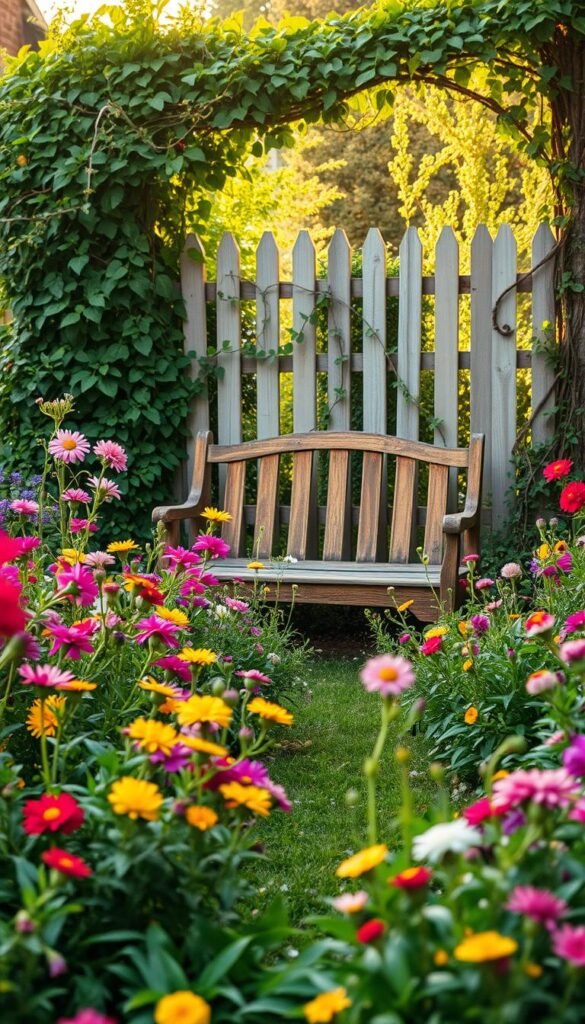
Imagine a spot where morning light filters through climbing roses as you sip tea, surrounded by buzzing pollinators. That’s the power of strategic seating in a cottage garden—it transforms vibrant plantings into lived-in experiences. Unlike static displays, these nooks invite you to pause and connect with nature’s rhythms.
Choosing the Ideal Bench Location
Position your seat where fragrance and beauty collide. Angle it toward scented stars like jasmine or phlox, ensuring afternoon shade in warmer climates. A Minnesota gardener shares: “My bench faces west—perfect for sunset views and catching evening breezes off the bee balm.”
Consider sight lines from inside your home too. A bench visible from your kitchen window becomes a year-round focal point, especially when dusted with winter frost. Pair it with evergreen shrubs or ornamental grasses for off-season texture.
Two-person benches work magic in compact spaces. Their intimate scale encourages lingering without overwhelming the garden style. For durability, choose rot-resistant cedar or powder-coated iron—materials that age gracefully with minimal care.
Beyond traditional options, try these ideas:
- Flank a birdbath with reclaimed church pews
- Build stone ledges into sloping beds
- Attach planter boxes to bench ends for vertical blooms
Your seating choice should whisper “stay awhile” while blending seamlessly with the landscape. As seasons change, so will your perspective—literally and figuratively.
Adding Vertical Interest with Trellises and Arbors
Ever thought your garden’s missing a third dimension? Vertical structures transform flat landscapes into layered wonderlands. Trellises aren’t just supports—they’re living art frames that keep your space vibrant through winter months when other plants sleep.
Selecting Suitable Vines for Trellises
Choose climbers that work with your cottage garden style. ‘Henryi’ clematis dazzles with dinner-plate blooms from June through September. Pair it with fragrant honeysuckle for nighttime allure. These vines thrive in partial shade, ideal for north-facing walls.
Balancing Height and Proportion in Your Design
A 7-foot trellis creates drama without overwhelming smaller yards. Place taller structures near seating areas to frame views. For narrow spaces, try DIY trellises using cedar strips—their warm tones complement flowering vines beautifully.
Remember: vertical elements should enhance, not dominate. Let roses soften angular metal arches, or train beans up bamboo poles. Your garden gains depth while keeping that carefree charm everyone loves.

